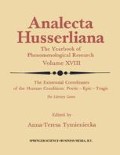Abstract
To begin with let us recall Sartre’s emphasis upon the societal aspect of literature. No literature exhibits the impact of the social life more clearly than Japanese literature. My paper will treat largely the “epic element” in Japanese literature rather than the epic as such. Since the definition of what constitutes the epic derives wholly from Western literature, quite obviously I should have had to take great liberties in applying that definition to a literature which has had such a different development. A glance at any of the numerous handbooks or glossaries of literary terms will suffice to show that the common features of literary epics are in fact derived from the traditional epics of Homer. One of these handbooks 1 gives five major features of the epic: (1) the hero is a figure of great national or international importance; (2) the setting is ample in scale, sometimes world-wide, or even larger; (3) the action involves heroic deeds in battle, or a long and arduous journey intrepidly accomplished; (4) in these great actions the gods and other supernatural beings themselves take an interest and an active part; (5) an epic poem is a ceremonial performance and is deliberately given a ceremonial style proportionate to its great subject and architecture.
Access this chapter
Tax calculation will be finalised at checkout
Purchases are for personal use only
Preview
Unable to display preview. Download preview PDF.
Notes
M. H. Abrams, A Glossary of Literary Terms (New York: Holt, Rinehart and Winston, 1957), p. 29.
Lady Murasaki, The Tale of Genji, translated by Arthur Waley (London: Allen and Unwin, 1935).
Lady Murasaki, The Tale of Genji, translated by Edward G. Seidensticker (New York: Knopf, 1976).
Waley, p. 749.
Seidensticker, p. 735.
Waley, p. 370.
Seidensticker, p. 337.
Ivan Morris, The World of the Shining Prince (Oxford: Oxford University Press, 1964), p. 208.
Waley, p. 194.
Utsukushisa to kanashimi to (Tokyo: Chūököronsha 1973); translated as Beauty and Sadness by Howard Hibbett (New York: Knopf, 1975).
The Ten Foot Square Hut and Tales of the Heike, translated by A. L. Sadler (Tokyo: Tuttle, 1972), p. 22.
Barbara Ruch, ‘Kakuichi’s Complaint: Homer and the Heike Hazards’ The Japan Interpreter (11, No. 2) Autumn 1976, pp. 229–236.
Ruch, p. 229.
Ruch, p. 229.
Ruch, p. 230.
The Tale of the Heike, translated by Hiroshi Kitagawa and Bruce T. Tsuchida, ‘Foreword,’ by Edward Seidensticker (Tokyo: University of Tokyo Press, 1975), p. xix.
Sadler, pp. 26, 28.
Kitagawa and Tsuchida, p. 369.
Kitagawa and Tsuchida, p. 651.
The most important work by far is the Gikeiki, a fifteenth-century work treating the life and exploits of Yoshitsune. It has been translated by Helen Craig McCullough as Yoshitsune: A Fifteenth-Century Japanese Chronicle (Stanford: Stanford University Press, 1966).
McCullough, pp. 4–5.
Sadler, p. 243.
Ruch, p. 231.
See Howard Hibbett. The Floating World in Japanese Fiction (Oxford: Oxford University Press, 1959), p. 42.
Ihara Saikaku, The Life of an Amorous Man, translated by Kengi Hamada (Tokyo: Tuttle, 1964), p. 11.
Donald Keene, World within Walls (New York: Holt, Rinehart and Winston, 1976), p. 179.
Keene, p. 169.
Keene, p. 172.
See Howard Hibbett, ‘Söseki and the Psychological Novel,’ Tradition and Modernization in Japanese Culture (Princeton: Princeton University Press, 1971).
Natsume Sōseki, Köjin (The Wayfarer), translated by Beongcheon Yu (Detroit: Wayne State University Press, 1967), p. 197.
Yu, p. 285.
Yu, p. 293.
Author information
Authors and Affiliations
Editor information
Rights and permissions
Copyright information
© 1984 Springer Science+Business Media Dordrecht
About this chapter
Cite this chapter
Viglielmo, V.H. (1984). The Epic Element in Japanese Literature. In: Tymieniecka, AT. (eds) The Existential Coordinates of the Human Condition: Poetic — Epic — Tragic. Analecta Husserliana, vol 18. Springer, Dordrecht. https://doi.org/10.1007/978-94-009-6315-3_15
Download citation
DOI: https://doi.org/10.1007/978-94-009-6315-3_15
Publisher Name: Springer, Dordrecht
Print ISBN: 978-94-011-7987-4
Online ISBN: 978-94-009-6315-3
eBook Packages: Springer Book Archive

